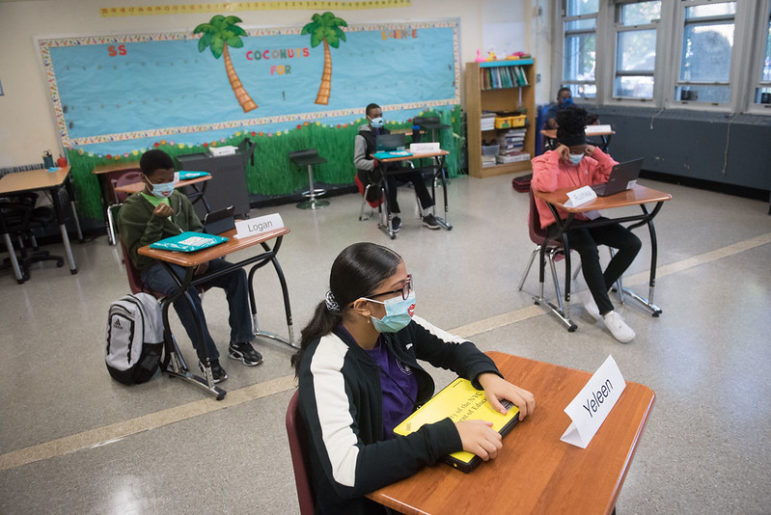Data released recently by the Department of Education for January shows students living in the shelter system saw the most absences, with a monthly attendance rate of 75.7 percent compared to the citywide rate for all students, which was 89.2 percent.

Michael Appleton/Mayoral Photography Office
Students in the Bronx at the start of the 2020-2021 school year.New York City students living in homeless shelters missed more school in January than any other group, recently released Department of Education data shows—raising concerns among advocates about the ongoing impact of COVID-19 on learning, especially for student populations they say were already marginalized before the pandemic.
The numbers, highlighted in a policy brief released Wednesday by Advocates for Children of New York (AFC), show the attendance rate for students in shelter during the first month of this year was 75.7 percent, 14.1 percentage points lower than students not living in the shelter system. The attendance rate for all city students in January, including those enrolled in both remote-only and blended learning, was 89.2 percent. That’s lower than it was pre-pandemic—the five-year average attendance rate before COVID-19 was 91.6 percent—but it’s an improvement from the start of the school year; the average attendance rate since Sept. 16 is 88.8 percent, according to the DOE.
The attendance numbers for January were published online by the DOE in mid-March, and offer the first detailed look at attendance during the current school year, according to AFC. The DOE was required to release the information following the passage of Local Law 10 at the start of the year, which mandates the agency publish monthly attendance numbers broken down in detailed categories, including grade, district, race and ethnicity. The law was an effort by local lawmakers to gauge the impact of remote learning on attendance and engagement.
In addition to those in the shelter system, the January figures reveal disparities among other student populations: English Language Learners (ELLs) and students with disabilities saw lower attendance that month than the city’s overall rate, as did Black and Hispanic students.
| Student Category | Overall Attendance Rate | Remote Students Online Attendance Rate | Blended Students Overall Attendance Rate | Blended Students In-Person Attendance Rate | Blended Students Online Attendance Rate |
| All Students | 89.2 | 89 | 89.8 | 90.2 | 89.7 |
| Students in Shelters | 75.7 | 75.6 | 76.3 | 78.4 | 75.6 |
| English Language Learners | 87 | 86.6 | 87.6 | 89 | 87.2 |
| Students with Disabilities | 85.3 | 84.8 | 86.3 | 87.3 | 85.9 |
| Asian Students | 94.9 | 95.2 | 93.4 | 93.1 | 93.5 |
| Black Students | 85.1 | 84.9 | 85.7 | 87.4 | 85.1 |
| Hispanic Students | 87 | 86.6 | 88 | 88.6 | 87.8 |
| Native American Students | 89.2 | 89.4 | 88.6 | 88.4 | 88.7 |
| White Students | 93.3 | 92.3 | 94.4 | 93.8 | 94.6 |
| Multi-Racial Students | 93.6 | 92.7 | 94.7 | 95 | 94.6 |
Attendance was also lower among high school students compared to younger grades: the rate for 10th graders was 81.4 percent, the lowest of all student age groups; 10th grade students living in homeless shelters had an attendance rate of just 64 percent.
“Tens of thousands of students are still struggling to access an education because of the pandemic or are at risk of disconnecting from school entirely,” Kim Sweet, executive director for AFC, said in statement Wednesday. “With the DOE poised to get billions of dollars in COVID-19 relief funding, now is the time to put forward a comprehensive plan for an equitable recovery.”
City schools are expected to receive nearly $7 billion in funds from the federal government’s COVID relief efforts. AFC is specifically calling for the DOE to use that money to provide make-up services and specialized support for students with disabilities, ELLs and students experiencing homelessness.
More than 50,000 students are slated to return to the city’s public schools for on March 26, after Mayor Bill de Blasio allowed families who’d previously chosen remote-only learning to opt-in again for in-person classes for the reminder of the school year.
The mayor also announced a new initiative this week to provide free academic support and enrichment programs this summer to students in each grade level. Families will be able to apply to for the new “Summer Rising” program starting April 26; the initiative will be run jointly by the DOE and the Department of Youth & Community Development, officials said.
“Our schools work with the entire school community to engage students and remove any barriers to daily attendance – with a special focus on our most vulnerable students. Our goal throughout the pandemic is supporting every student no matter their circumstances and in whatever way they need,” DOE Spokesperson Nathaniel Styer told City Limits in a statement. “To that end, we are welcoming 51,000 more students to in-person learning at the end of the month, and offering a groundbreaking, enriching summer program for any student who wants to attend.”
The DOE says it has more than 300 field-staffers and 100 social workers assigned to support students in temporary housing, and the city has prioritized these students in placement at its placement at Learning Bridges centers, which provides free childcare for qualifying families.
This article is part of a series supported by the Family Homelessness Coalition. City Limits is solely responsible for the content.








